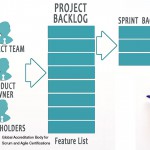A Scrum project involves a collaborative effort to create a new product, service, or other result as defined in the Project Vision Statement. Projects are impacted by constraints of time, cost, scope, quality, resources, organizational capabilities, and other limitations that make them difficult to plan, execute, manage, and ultimately succeed. However, successful implementation of the results of a finished project provides significant business benefits to an organization. It is therefore important for organizations to select and practice an appropriate project management methodology.
Scrum is one of the most popular Agile framework. It is an adaptive, iterative, fast, flexible, and effective framework designed to deliver significant value quickly and throughout a project. Scrum ensures transparency in communication and creates an environment of collective accountability and continuous progress. The Scrum framework is structured in such a way that it supports product and service development in all types of industries and in any type of project, irrespective of its complexity.
A key strength of Scrum lies in its use of cross-functional, self-organized, and empowered teams who divide their work into short, concentrated work cycles called Sprints. The image below provides an example of an overview of a Scrum project’s flow.

The Scrum cycle begins with a Stakeholder Meeting, during which the Project Vision is created. The Product Owner then develops a Prioritized Product Backlog which contains a prioritized list of business and project requirements written in the form of User Stories. Each Sprint begins with a Sprint Planning Meeting during which high priority User Stories are considered for inclusion in the Sprint. A Sprint generally lasts between one and six weeks and involves the Scrum Team working to create potentially shippable Deliverables or product increments. During the Sprint, short, highly focused Daily Standup Meetings are conducted where team members discuss daily progress.
Toward the end of the Sprint, a Sprint Review Meeting is held during which the Product Owner and relevant stakeholders are provided a demonstration of the Deliverables. The Product Owner accepts the Deliverables only if they meet the predefined Acceptance Criteria. The Sprint cycle ends with a Retrospect Sprint Meeting where the team discusses ways to improve processes and performance as they move forward into the subsequent Sprint.









